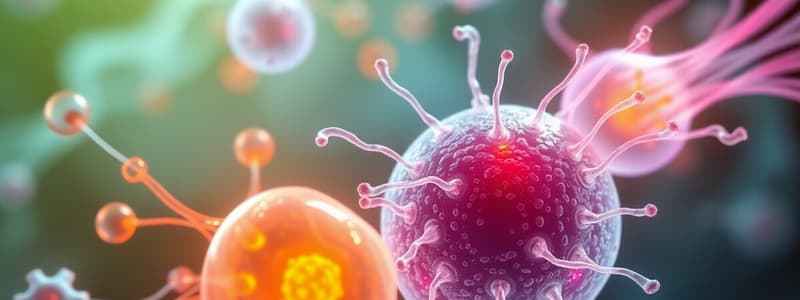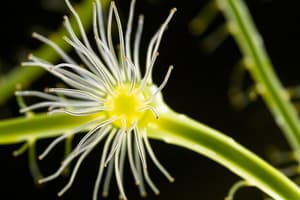Podcast
Questions and Answers
What is the primary function of cilia and flagella in eukaryotic cells?
What is the primary function of cilia and flagella in eukaryotic cells?
- They assist in cell division.
- They provide movement for the cell. (correct)
- They support the cell structure.
- They are involved in metabolic reactions.
Which statement best describes the process of osmosis?
Which statement best describes the process of osmosis?
- It requires energy to move water across a membrane.
- It involves the active transport of ions only.
- It is the passive movement of water across a selectively permeable membrane. (correct)
- It is the movement of solutes from an area of low concentration to high concentration.
What is an endergonic reaction characterized by?
What is an endergonic reaction characterized by?
- Releases energy to the surroundings.
- Has a negative change in free energy.
- Requires energy input to proceed. (correct)
- Occurs spontaneously without the need for energy.
What are the final waste products of cellular respiration?
What are the final waste products of cellular respiration?
Which structure in the chloroplast is primarily involved in the light-dependent reactions of photosynthesis?
Which structure in the chloroplast is primarily involved in the light-dependent reactions of photosynthesis?
How many ATP molecules are produced during glycolysis?
How many ATP molecules are produced during glycolysis?
What role do NAD and NADP play in cellular processes?
What role do NAD and NADP play in cellular processes?
What molecule serves as the primary reaction molecule in photosynthesis?
What molecule serves as the primary reaction molecule in photosynthesis?
How do autotrophs primarily obtain energy?
How do autotrophs primarily obtain energy?
What characterizes a competitive inhibitor in enzyme reactions?
What characterizes a competitive inhibitor in enzyme reactions?
Which component of chloroplasts is primarily responsible for the light-independent reactions?
Which component of chloroplasts is primarily responsible for the light-independent reactions?
What is the primary function of phospholipids in cell membranes?
What is the primary function of phospholipids in cell membranes?
What occurs during substrate-level phosphorylation?
What occurs during substrate-level phosphorylation?
Which of the following is a potential effect on enzyme function?
Which of the following is a potential effect on enzyme function?
What distinguishes prokaryotic cells from eukaryotic cells?
What distinguishes prokaryotic cells from eukaryotic cells?
How many times must the Calvin Cycle go around to produce one molecule of glucose?
How many times must the Calvin Cycle go around to produce one molecule of glucose?
Flashcards are hidden until you start studying
Study Notes
Cilia and Flagella
- Cilia and flagella are hair-like structures that project from the surface of cells.
- Cilia are short and numerous, while flagella are long and few in number.
- Both cilia and flagella are involved in cell movement.
Major Organelles of Eukaryotic Cells
- Nucleus: Contains the cell's genetic material (DNA) and controls cellular activities.
- Ribosomes: Responsible for protein synthesis.
- Endoplasmic Reticulum (ER): A network of membranes involved in protein and lipid synthesis.
- Golgi Apparatus: Modifies, sorts, and packages proteins and lipids for secretion or delivery to other organelles.
- Mitochondria: The powerhouse of the cell, responsible for ATP production through cellular respiration.
- Lysosomes: Contain enzymes for digesting waste products and cellular debris.
- Vacuoles: Store water, nutrients, and waste products.
Phospholipids
- Phospholipids are the primary building blocks of cell membranes.
- Composed of a hydrophilic head (phosphate group) and a hydrophobic tail (fatty acid chains).
- Form a bilayer in cell membranes, with the hydrophilic heads facing outwards and the hydrophobic tails facing inwards.
Osmosis
- Osmosis is the movement of water across a semipermeable membrane from a region of high water concentration to a region of low water concentration.
- This movement is driven by the difference in water potential.
- Osmosis is essential for maintaining cell volume and fluid balance.
Diffusion, Passive Transport, Active Transport, and Bulk Transport
- Diffusion: The spontaneous movement of molecules from an area of high concentration to an area of low concentration.
- Passive transport: Movement of molecules across a membrane without requiring energy. This includes simple diffusion, facilitated diffusion, and osmosis.
- Active transport: Movement of molecules across a membrane against their concentration gradient, requiring the use of energy (ATP).
- Bulk transport: Movement of large molecules or particles across a membrane using vesicles. Includes endocytosis (taking material into the cell) and exocytosis (releasing material out of the cell).
Ultimate Source of Energy
- The ultimate source of energy for life on Earth is the Sun.
Laws of Thermodynamics
- First Law of Thermodynamics: Energy cannot be created or destroyed, only transformed from one form to another.
- Second Law of Thermodynamics: Every energy transfer or transformation increases the entropy (disorder) of the universe.
Enzymes and Substrates
- Enzymes: Biological catalysts that speed up chemical reactions without being consumed in the process.
- Substrate: The specific molecule that an enzyme binds to and acts upon.
- Enzymes have an active site where the substrate binds.
Oxidation-Reduction Reactions
- Reactions involving the transfer of electrons.
- Oxidation: Loss of electrons, resulting in a decrease in potential energy.
- Reduction: Gain of electrons, resulting in an increase in potential energy.
- Often occur together, as one molecule is oxidized while another is reduced.
Autotrophs and Heterotrophs
- Autotrophs: Organisms that produce their own food from inorganic sources, such as sunlight (e.g., plants).
- Heterotrophs: Organisms that obtain their food by consuming other organisms (e.g., animals).
Light Dependent and Light Independent Reactions of Photosynthesis
- Light Dependent Reactions: Occur in the thylakoid membranes of chloroplasts.
- Convert light energy into chemical energy in the form of ATP and NADPH.
- Water is split, releasing oxygen as a byproduct.
- Light Independent Reactions (Calvin Cycle): Occur in the stroma of chloroplasts.
- Use ATP and NADPH produced in the light dependent reactions to convert carbon dioxide into glucose.
Thylakoids and Stroma
- Thylakoids: Disk-shaped structures within chloroplasts, arranged in stacks called grana.
- Contain chlorophyll, the pigment that absorbs light energy for photosynthesis.
- Stroma: The fluid-filled region surrounding the thylakoids.
- Contains enzymes for the Calvin Cycle.
Photosystems
- Photosystem I (PSI): Absorbs light energy and uses it to reduce NADP+ to NADPH.
- Photosystem II (PSII): Absorbs light energy and uses it to split water molecules, releasing oxygen and producing ATP.
Color Not Absorbed by Green Plants
- Green plants do not absorb green light, which is why they appear green.
Prokaryotic and Eukaryotic Cells
- Prokaryotic cells: Simple cells lacking a nucleus and membrane-bound organelles (e.g., bacteria).
- Eukaryotic cells: Complex cells with a nucleus and membrane-bound organelles (e.g., plants, animals, fungi).
Endocytosis, Exocytosis, and Receptor-Mediated Endocytosis
- Endocytosis: Process of taking material into the cell by engulfing it in a membrane-bound vesicle.
- Exocytosis: Process of releasing material out of the cell by fusing a vesicle with the cell membrane.
- Receptor-mediated endocytosis: A specific type of endocytosis where molecules bind to receptors on the cell surface, triggering the formation of a vesicle.
Endergonic and Exergonic Reactions
- Endergonic reactions: Reactions that require energy input (positive ΔG), for example, photosynthesis.
- Exergonic reactions: Reactions that release energy ( negative ΔG), for example, cellular respiration
Active Site, Allosteric Site, Competitive and Non-Competitive Inhibition
- Active site: The region on an enzyme where the substrate binds.
- Allosteric site: A site on an enzyme that, when bound to a regulatory molecule, can alter the enzyme's activity.
- Competitive inhibition: A type of inhibition where the inhibitor competes with the substrate for the active site of the enzyme.
- Non-competitive inhibition: A type of inhibition where the inhibitor binds to a site other than the active site, altering the enzyme's shape and making it less active.
Factors Affecting Enzyme Function
- Temperature: Enzymes have an optimal temperature range. Excessive heat can denature (destroy) the enzyme.
- pH: Enzymes have an optimal pH range. Extreme pH values can denature the enzyme
- Substrate concentration: Enzyme activity increases as substrate concentration increases until saturation is reached.
- Cofactors and coenzymes: Some enzymes require non-protein molecules (cofactors and coenzymes) to function properly.
Function of NAD and NADP
- NAD+ (nicotinamide adenine dinucleotide): A coenzyme involved in many redox reactions, carrying electrons from one reaction to another.
- NADP+ (nicotinamide adenine dinucleotide phosphate): A coenzyme involved in photosynthesis, carrying electrons from one reaction to another.
Substrate Level Phosphorylation and Oxidative Phosphorylation
- Substrate-level phosphorylation: The direct transfer of a phosphate group from a substrate molecule to ADP to produce ATP.
- Oxidative phosphorylation: The production of ATP using the energy released from the electron transport chain and the proton gradient across the mitochondrial membrane.
Glycolysis
- Glycolysis is a metabolic pathway that occurs in the cytoplasm.
- It breaks down glucose into pyruvate, producing ATP.
- Glycolysis can occur with or without oxygen.
Cellular Respiration
- The process of breaking down glucose to produce ATP.
- Aerobic respiration: Requires oxygen to produce a significant amount of ATP. Occurs in four stages: glycolysis, pyruvate oxidation, Krebs cycle/citric acid cycle, and oxidative phosphorylation.
- Anaerobic respiration: Occurs in the absence of oxygen, producing a small amount of ATP.
ATP Production in Cellular Respiration
- Glycolysis: Produces 2 ATP molecules.
- Pyruvate oxidation and the Krebs Cycle: Produce 2 ATP molecules.
- Oxidative phosphorylation: Produces about 32 ATP molecules.
Locations of Cellular Respiration
- Glycolysis: Occurs in the cytoplasm.
- Pyruvate Oxidation: Occurs in the mitochondrial matrix.
- Krebs Cycle/Citric Acid Cycle: Occurs in the mitochondrial matrix.
- Oxidative Phosphorylation: Occurs in the inner mitochondrial membrane.
Final Product of Glycolysis
- Pyruvate
Final Waste Products of Cellular Respiration
- Carbon dioxide and water
Equations for Photosynthesis and Cellular Respiration
- Photosynthesis: 6CO2 + 6H2O + light energy → C6H12O6 + 6O2
- Cellular Respiration: C6H12O6 + 6O2 → 6CO2 + 6H2O + energy (ATP)
Role of Water in Photosynthesis
- Water is a reactant in photosynthesis, providing electrons and protons.
- Oxygen is a byproduct of splitting water molecules.
Reaction Molecule of Photosynthesis
- Carbon dioxide (CO2)
Molecules Produced in the Calvin Cycle
- Glucose (C6H12O6)
Photon
- A tiny packet of light energy.
Number of Calvin Cycle Turns to Make One Glucose
- 6 turns of the Calvin cycle are required to produce one molecule of glucose.
Plant vs. Animal Cells
- Plant Cells
- Have a cell wall made of cellulose that provides structural support.
- Have chloroplasts for photosynthesis.
- Have a large central vacuole for storage and maintaining turgor pressure.
- Animal Cells:
- Lack a cell wall.
- Lack chloroplasts.
- Have smaller vacuoles.
Stomata
- Stomata: Tiny pores on the surface of plant leaves.
- Purpose: Allow for gas exchange (entry of carbon dioxide and exit of oxygen).
- Regulation: Stomata open and close to regulate gas exchange and prevent water loss.
Studying That Suits You
Use AI to generate personalized quizzes and flashcards to suit your learning preferences.




